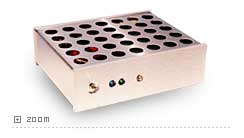Quote:
Originally Posted by clarke68
Jazz mentioned he knew a better way to balance a room than the frequency sweep method you described, I'd just like to hear about it because I don't know of a better way...at least not one that uses pink noise.
|
A certain Amar G. Bose (yes, this one!) once has found out that in an average concert hall (and I suppose on an average listening position) 89% of the sound reaching our ears is reflected and only 11% comes directly from the orchestra. Based on this insight he created a speaker with nine fullrange drivers, one radiating to the front and eight to the back, producing about 3% direct and 97% reflected sound (numbers guessed). The discrepancy to the intended and propagated 11/89 percentage is caused by the fact that the sound radiated by the front driver -- of course -- not only produces direct sound, but a fair amount of indirect sound as well (just like ordinary direct-radiating speakers, BTW)...
This little escapade just serves for demonstrating the importance of indirect sound for music reproduction. I don't know the numbers for an average listening room, but I guess clearly more than 50% of the sound reaching the ears is reflected sound. Its dispersion within the room is extremely irregular, due to the radiation characteristic of common speakers. While on axis the FR is meant to be quite even, off axis it becomes more and more inhomogeneous, following the drivers' tendency to radiate lower frequencies spherically and focus higher frequencies within its usable frequency range. Vertically (given the drivers are placed on top of each other) the comb filter effect takes effect: Interferences between overlapping frequency areas cause severe cancellations and amplifications in FR. The latter now has no similarity to the on-axis FR anymore. And that's what's radiated to and reflected from the ceiling. Further back there are no high frequencies anymore, so what's reflected from the wall behind the speakers is virtually just lows and mids, with a quite uneven spectrum.
So the dispersion of indirect sound in the listening room has a rather chaotic pattern. Now if we're going to measure the FR of the speakers, what's our goal? Are we interested in the direct-sound frequency response (actually a legitimate goal, considering the sonic colors of the music instruments we may want to have preserved) or do we want to measure the over-all frequency response, with its inhomogeneous mixture of direct and reflected sound? For the first case there's the possibility of a near-field (problematic because of driver interaction and directivity) or FFT measurement which virtually excludes room acoustics. But then again, it can't be denied that room acoustics have a decisive function when it comes to sound perception. It's just that the microphone isn't able to differentiate between direct and reflected sound, which nevertheless has a certain importance, because our ears
are able to differentiate between them. Add to this that in fact the microphones should have the exact same directivity as our ears to provide a FR corresponding to the one we will perceive. Of course that's illusionary.
So my solution is to simply use my ears as measuring array. Now sine sweeps will be affected by extreme amplitude jumps caused by the interferences between the erratic sound waves (like the jagged curve above shows), so it will be extremely difficult if not impossible to draw any conclusion about their amplitude dispersion throughout the frequency spectrum. A much better signal for this purpose is
pink noise. Although it will not clearly reveal a tilted curve -- this will just make for a brighter or darker noise which still sounds «right» in some way --, it's quite easy to hear colorations in it, and a parametric equalizer helps with identifying them quite reliably (by correcting them!). Pink noise sounds sort of like a waterfall; and we all know how this should sound.
This method has the advantage of being able -- to a certain degree -- to take direct and reflected sound into account: Your ears tell you how much to follow which parameter: the mere direct sound and the sum of direct and reflected sound. Intuitively, without analyzing. Finally music with its high content of transients and as a real-life signal will offer the opportunity to identify which frequency areas still need to be tweaked in order to achieve an optimal «subjective» frequency response as a synthesis of direct and over-all FR. This method has served me well for tuning my speakers, more precisely their crossover network. It's the only function of my equalizer at all.







